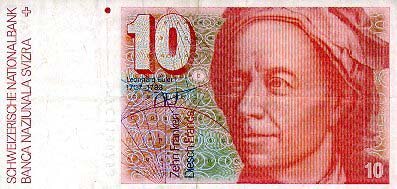 |
| Euler on the 10 franc banknote (Serie 1975 - 1995) |
The scientist Leonhard Euler, who was born in Basel and later moved to St.~Petersburg is famous for his work in the field of mathematics. Less is known about his important contributions in the field of friction physics. He studied theoretically the mechanism of the sliding motion of a block on an inclined plane. He adopted the model of rigid interlocking asperities as the cause of frictional resistance. (Euler considered Leonardo's experiments of the sliding block on the inclined plane.}
He assumed that the friction force results from gravitational forces, trying to minimize the potential energy of the block. He found the relation  between inclination angle a and friction coefficient m. We find this relation also by equating the friciton force with the accelerating force: between inclination angle a and friction coefficient m. We find this relation also by equating the friciton force with the accelerating force:



Assuming a velocity-independent friction coefficient, he found, that for the critical angle a the acceleration of the block should be exceedingly small, since gravity is nearly compensated by kinetic friction. This result was against the experimental facts, where sliding started relatively fast. He concluded, that one has to distinguish between static and kinetic friction and that static friction is always larger than kinetic friction. With these assumptions he was able to describe the motion of a block on an inclined plane. Euler was the first who distinguished between static and kinetic friction.
|